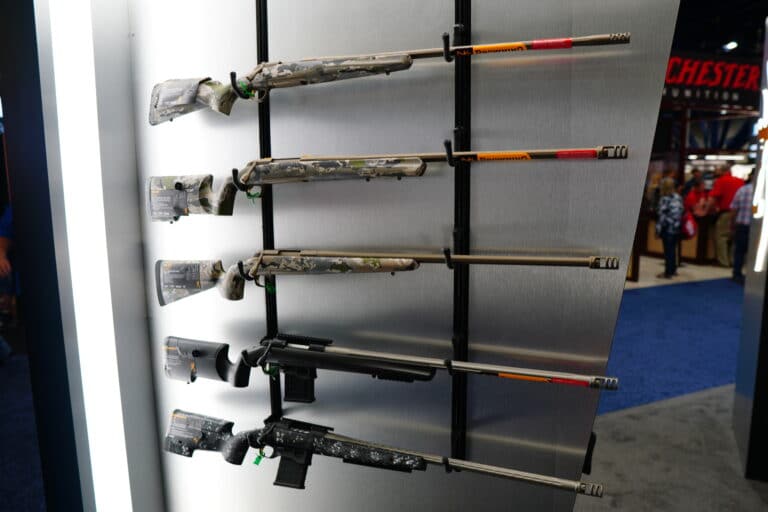A federal appeals court reversed a Texas man’s conviction for possessing a firearm while he was subject to a domestic violence restraining order.
A three-judge panel of the Fifth Circuit unanimously vacated the man’s conviction on Thursday, finding the federal gun law he was charged under conflicts with the Second Amendment. The panel ruled the federal ban on the possession of guns by those subject to restraining orders did not survive the test laid out in the Supreme Court’s recent New York State Rifle and Pistol Association v. Bruen ruling. It found insufficient evidence that the restraining order restriction was part of the “historical tradition” of gun regulation, as required by Bruen.
“The Government fails to demonstrate that § 922(g)(8) ‘s restriction of the Second Amendment right fits within our Nation’s historical tradition of firearm regulation. The Government’s proffered analogues falter under one or both of the metrics the Supreme Court articulated in Bruen as the baseline for measuring ‘relevantly similar’ analogues: ‘how and why the regulations burden a law-abiding citizen’s right to armed self-defense,'” Judge Cory T. Wilson wrote for the panel in United States v. Rahimi. “As a result, § 922(g)(8) falls outside the class of firearm regulations countenanced by the Second Amendment.”
The ruling is the latest in a string of decisions that attempt to suss out the new limits of Second Amendment protections after the landmark ruling. It is only one of a handful of post-Bruen cases that have been decided at the appellate court level. That makes it a prime candidate to be one of the next gun cases heard by the Supreme Court should the Department of Justice (DOJ) decide to appeal the decision.
The case stems from the conviction of Zackey Rahimi. The defendant admitted to possessing guns in violation of a restraining order taken out against him by the mother of his child over an act of “family violence.” Police found the firearms in question after searching Rahimi’s residence due to multiple other crimes he is alleged to have committed. DOJ said in court filings that Rahimi has been accused of being involved in at least five different shootings over the course of six weeks between December 2020 and January 2021, including shooting at someone he’s accused of selling Percocet to, someone he cut off in traffic, and shooting in the air at a Whataburger after his friend’s credit card was declined.
The Fifth Circuit ruling means that Rahimi will not serve the 73-month sentence he was given for violating the restraining order’s gun prohibition. However, he still faces five different cases in state court stemming from the shooting incidents.
The case was a criminal appeal and did not feature either gun-rights or gun-control advocates as parties to the case. However, gun-control advocates decried the decision as potentially harmful to survivors of domestic violence.
“This extreme and dangerous ruling is a death sentence for women and families as domestic violence is far too often a precursor to gun violence,” Shannon Watts, founder of Moms Demand Action, said in a statement. “When someone is able to secure a restraining order, we must do everything possible to keep them and their families safe — not empower the abuser with easy access to firearms. This ruling cannot stand and must quickly be overturned.”
Janet Carter, senior director of issues and appeals at Everytown Law, called on higher courts to take up the case and throw out the panel’s decision.
“If the full Fifth Circuit doesn’t reverse this misguided decision, the Supreme Court should do so,” she said.
The Department of Justice did not reply to a request for comment on whether or when they plan to appeal.
The decision reverses the Fifth Circuit’s previous take on the domestic violence restraining order law. The court had previously upheld convictions under the law as consistent with the Second Amendment. However, it did so under a two-step balancing test the Supreme Court expressly rejected in Bruen, and the three-judge panel ruled that the law, no matter how well-intentioned, could not be justified under the new test.
“Doubtless, 18 U.S.C. § 922(g)(8) embodies salutary policy goals meant to protect vulnerable people in our society,” Judge Wilson wrote. “Weighing those policy goals’ merits through the sort of means-end scrutiny our prior precedent indulged, we previously concluded that the societal benefits of § 922(g)(8) outweighed its burden on Rahimi’s Second Amendment rights. But Bruen forecloses any such analysis in favor of a historical analogical inquiry into the scope of the allowable burden on the Second Amendment right. Through that lens, we conclude that § 922(g)(8)’s ban on possession of firearms is an ‘outlier that our ancestors would never have accepted.’ Therefore, the statute is unconstitutional, and Rahimi’s conviction under that statute must be vacated.”
The panel’s ruling examined historical laws from near the founding era offered by the government as potential analogues for the restraining order gun ban. It determined laws about disarming groups of people perceived as dangerous, barring people from “going armed to the terror of the people,” and laws requiring people specifically accused of being dangerous to post sureties to carry a gun in public were not relevantly similar. The court wrote those laws either applied to different groups, required convictions, or resulted in lighter punishment than the modern domestic violence law.
“[O]n substance, the early ‘going armed’ laws that led to weapons forfeiture are not relevantly similar to § 922(g)(8),” Judge Wilson wrote. “First, those laws only disarmed an offender after criminal proceedings and conviction. By contrast, § 922(g)(8) disarms people who have merely been civilly adjudicated to be a threat to another person. Moreover, the ‘going armed’ laws, like the ‘dangerousness’ laws discussed above, appear to have been aimed at curbing terroristic or riotous behavior, i.e., disarming those who had been adjudicated to be a threat to society generally, rather than to identified individuals.”
The judges said surety laws came closest to the modern law, but still fell flat as an analogue.
“The surety laws required only a civil proceeding, not a criminal conviction,” they said. “The ‘credible threat’ finding required to trigger § 922(g)(8) ‘s prohibition on possession of weapons echoes the showing that was required to justify posting of surety to avoid forfeiture. But that is where the analogy breaks down: As the Government acknowledges, historical surety laws did not prohibit public carry, much less possession of weapons, so long as the offender posted surety.”
The ruling comes after Judge David Counts of the U.S. District of Western Texas ruled the federal prohibition on those under felony indictment obtaining guns was similarly unconstitutional. Both courts focused mainly on the lower level of evidence required for getting an indictment or restraining order and reduced protections afforded to those accused when compared to convictions from criminal proceedings as key faults with the laws. They also suggest the government can still disarm people after they are convicted, as Counts ruled shortly after tossing the indictment-based ban.
Judge James C. Ho, who signed onto the Fifth Circuit ruling, elaborated in a concurrence that the right to keep and bear arms is “entirely compatible” with the “fundamental role of government in protecting citizens against violence,” even if the Second Amendment precludes gun bans based on restraining orders.
“Our Founders understood that those who commit or threaten violence against innocent law-abiding citizens may be arrested, convicted, and incarcerated,” he wrote. “They knew that arrest and incarceration naturally entails the loss of a wide range of liberties—including the loss of access to arms.”
He said when the government seeks to disarm somebody lawfully, “it must do so consistent with the fundamental protections that our Constitution affords to those accused of a crime.” He said this is also possible for those who merely threaten violence against others or who are still going through the judicial process, but only when coupled with the appropriate legal protections.
“Pre-trial detention is expressly contemplated by the Excessive Bail Clause and the Speedy Trial Clause. And it no doubt plays a significant role in protecting innocent citizens against violence,” Judge Ho said. “Our laws also contemplate the incarceration of those who criminally threaten, but have not (yet) committed, violence. After all, to the victim, such actions are not only life-threatening—they’re life-altering.”





